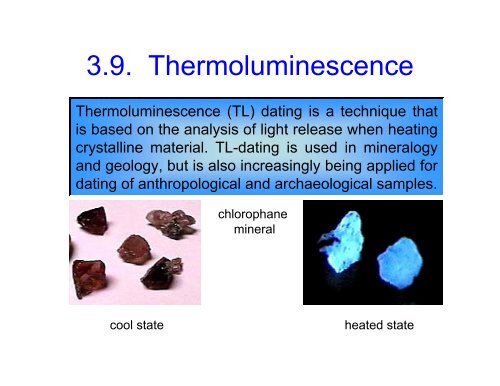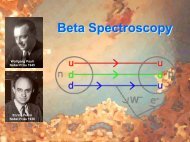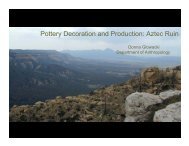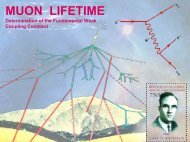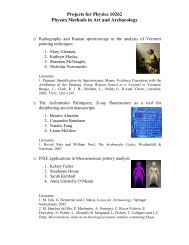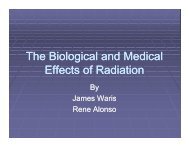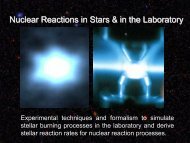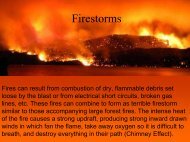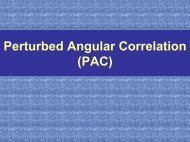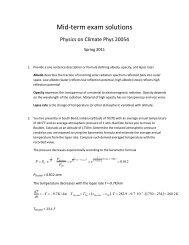3.9. Thermoluminescence
3.9. Thermoluminescence
3.9. Thermoluminescence
Create successful ePaper yourself
Turn your PDF publications into a flip-book with our unique Google optimized e-Paper software.
<strong>3.9.</strong> <strong>Thermoluminescence</strong><br />
<strong>Thermoluminescence</strong> (TL) dating is a technique that<br />
is based on the analysis of light release when heating<br />
crystalline material. TL-dating is used in mineralogy<br />
and geology, but is also increasingly being applied for<br />
dating of anthropological and archaeological samples.<br />
chlorophane<br />
mineral<br />
cool state<br />
heated state
Applicability of TL dating<br />
TL dating is mainly applicable for material with mineral or<br />
crystalline structure or with spurious crystalline contents. It<br />
is only usable of insulating material not for metallic artifacts.<br />
In archaeology TL<br />
is mainly used for<br />
pottery analysis.<br />
In anthropology the main use of<br />
TL is the dating of flint stone as<br />
early tool material for mankind.
The glow curve<br />
first heating<br />
second heating<br />
Typical phenomenon of thermoluminescence, when sample is<br />
heated above 200 o C, light emission in blue range is observed<br />
up to 400 o C. At higher temperature, material emits a red glow.<br />
For second heating no blue light emission is observed, only<br />
the red glow curve remains at the higher temperature range.
Origin of thermoluminescence<br />
<strong>Thermoluminescence</strong> (TL) originates from the temperature<br />
induced release of energy, stored in the lattice structure of<br />
the crystal following long-term internal and external<br />
exposure to nuclear radiation from natural sources.<br />
TL accumulates in the<br />
material with time<br />
depending on the<br />
radiation (and light)<br />
exposure. The TL is<br />
released by heating.<br />
The dating clock starts<br />
with the initial firing of<br />
the material, when<br />
originally accumulated<br />
TL is being driven out.
Age determination<br />
the amount of accumulated TL is proportional to<br />
the age of the sample and inverse proportional<br />
to the nuclear radiation exposure of the sample.<br />
Age<br />
=<br />
Archaeological TL<br />
(Annual Dose) ⋅ (TL/unit dose)<br />
Annual Dose:<br />
D<br />
t<br />
=<br />
m<br />
E<br />
⋅<br />
t<br />
Amount of energy E deposited by<br />
radiation exposure into sample of<br />
mass m within one year. It depends<br />
on the content of radioactive nuclei<br />
in the sample material and on the<br />
exposure to external radioactivity.
eminder from Chapter 1.2:<br />
Dose: D =<br />
E m<br />
Amount of energy E deposited<br />
by radiation into body of mass m.<br />
1 Gray (Gy) = 1 Joule/kg (Energy/mass)<br />
1 rad = 1 centigray = 10 milligrays ( 1 rad = 1cGy = 10 mGy )<br />
Nominal background radiation absorbed dose 100 mrad/year = 1 mGy/yr.<br />
TL/unit dose is material specific. It describes the probability for<br />
a material to develop thermoluminescence (TL) under<br />
radiation exposure. This has to be determined by independent<br />
analysis typically by exposure to well defined radioactive<br />
sources. For metals: TL/unit dose =0
experimental set-up<br />
heater with temperature control; blue<br />
filter for red light glow absorption and<br />
photomultiplier with scintillator for TL<br />
photon measurement.
Example 1<br />
52 000 TL-cts/(s·0.1Gy)<br />
The TL curve shows 21000 TL-counts/s<br />
at an average annual dose of 1 mGy/y<br />
TL [10 3 cts/s]<br />
21 000 TL-cts/s<br />
Measurement of TL with an<br />
calibrated source gives 52000<br />
TL-cts/s after an exposure to<br />
0.1Gy radiation.<br />
TL/dose= 520000 TL-cts/(s·Gy)<br />
temperature o C<br />
-1<br />
Age = 21000[s ]<br />
−3<br />
-1<br />
1⋅10<br />
[Gy/y] ⋅520000[s<br />
⋅ Gy<br />
−1<br />
]<br />
Age = 4038y
The Plateau Test<br />
two portions of the sample are TL tested, one after additional<br />
exposure to radioactive source (β radiation) and one without<br />
additional exposure - paleodose.<br />
Ratio of the two<br />
TL curves should<br />
provide a plateau<br />
in the TL range.<br />
short-lived TL components
The plateau method<br />
The plateau method – initial developed as an independent test –<br />
provides a more reliable method since with this relative approach<br />
the systematic uncertainties in the absolute dose rates cancel out.<br />
Age =<br />
paleodose<br />
annual dose<br />
The paleodose is the natural dose received by sample since<br />
its last heating (production); it can be determined from the<br />
plateau ratio R between the paleodose and the paleodose<br />
plus the source related dose from the sample irradiation. The<br />
annual dose is material dependent and must be measured.
Paleodose Determination<br />
N<br />
R =<br />
N + N<br />
β<br />
R ⋅(<br />
N + N<br />
β<br />
) =<br />
R ⋅ N<br />
β<br />
= N( 1−<br />
N<br />
β<br />
N =<br />
−<br />
( R<br />
1 −1)<br />
N<br />
R )<br />
If R=0.5 (R -1 =2) the sample<br />
received during the source<br />
irradiation the same dose<br />
as naturally over its life<br />
time. If R=0.33 (R -1 =3) the<br />
sample received during the<br />
source irradiation twice the<br />
natural life time dose.
Example 2<br />
N β =10 Gy<br />
N<br />
β<br />
R = 0.<br />
47;<br />
N =<br />
= 0.<br />
886 ⋅ N<br />
β<br />
( 1/<br />
0.<br />
47 −1)<br />
with N<br />
β<br />
= 10 Gy; Paleodose : N = 8.<br />
86 Gy
Annual Dose Determination<br />
For most pottery samples the TL is produced in roughly equal<br />
proportions by the nuclear radiation from potassium 40 K (β, γ<br />
emitter), thorium (α-emitter), and uranium (α-emitter) plus its<br />
additional β and γ radiation which is emitted along the decay<br />
chains. Minor contributions yield from rubidium contamination<br />
(β-emission) and cosmic radiation bombardment.<br />
Annual<br />
dose :<br />
= D<br />
'<br />
D D<br />
α β γ<br />
D + + +<br />
D<br />
cr<br />
α radiation saturates the TL traps due to its high ionization<br />
probability, therefore only 10-15% of the α leads to TL dose.<br />
D '<br />
α<br />
= k ⋅ D k<br />
α α α<br />
≈<br />
0 . 1−<br />
0.<br />
15
fine and coarse grain method<br />
• the fine grain method seeks to maximize the α-dose<br />
in sample powder of<br />
3-10 μm grain size!<br />
0.5mm<br />
• the coarse grain method is<br />
based only on β and γ induced luminescence using<br />
a coarse powder with more than 500 μm grain size !
Annual doses for typical pottery<br />
fine grain technique
Example 3 (fine grain method)<br />
Annual dose for ‘typical’ pottery and soil conditions<br />
can be estimated (neglecting Cosmic Ray Dose):<br />
D<br />
=<br />
(<br />
k<br />
⋅<br />
D<br />
α<br />
+<br />
D<br />
β<br />
+<br />
D<br />
γ<br />
)<br />
D<br />
=<br />
(<br />
2.<br />
36<br />
⋅10<br />
−3<br />
+ 1.<br />
58⋅10<br />
−3<br />
+ 1.<br />
24<br />
⋅10<br />
−3<br />
) [Gy/y]<br />
D<br />
=<br />
5.<br />
18⋅10<br />
−3<br />
[Gy/y]<br />
Comparison with the paleodose yields an age of:<br />
paleodose 8.<br />
86 [Gy]<br />
Age = =<br />
=<br />
−3 annual dose 5.<br />
18 ⋅10<br />
[Gy/y]<br />
1710 [y]
Uncertainties & Problems<br />
If sample has been exposed to light for considerable time<br />
bleaching may occur, de-excitation of TL traps by photon<br />
interaction. TL drops, suggesting a lower paleodose & age.<br />
TL<br />
≈ 0.72·TL<br />
a) natural TL curve<br />
b) after 1h light exposure<br />
c) after 24 h light exposure<br />
≈ 0.15·TL<br />
since age is proportional<br />
to paleodose, significant<br />
errors can occur!
leaching time dependence<br />
Since the light exposure causes photon induced de-excitation of<br />
intra-band states the TL drops exponentially with exposure time t.<br />
TL( t<br />
κ<br />
=<br />
)<br />
=<br />
TL<br />
0<br />
material<br />
⋅<br />
e<br />
−κ ⋅t<br />
constant<br />
Quartz is more slowly bleached than Feldspar, if κ and<br />
light exposure time t is known, corrections can be applied.
leached piece of pottery<br />
unbleached case:<br />
paleodose 8.<br />
86 [Gy]<br />
Age = =<br />
=<br />
−3 annual dose 5.<br />
18 ⋅10<br />
[Gy/y]<br />
1710 [y]<br />
κ=0.33: 1 h bleached case: paleodose is reduced to 72%:<br />
paleodose 6.<br />
38 [Gy]<br />
Age = =<br />
=<br />
−3 annual dose 5.<br />
18 ⋅10<br />
[Gy/y]<br />
1231[y]<br />
sample appears considerably younger!
water uptake and water damage<br />
Pottery within a meter or so from ground level are typically<br />
wet! Water uptake has direct impact on annual dose since it<br />
acts as absorber material for the radiation. Wet pottery has<br />
lower annual dose suggesting a higher age of pottery sample.<br />
Reduction in dose rates for α, β, and γ exposure is:<br />
k<br />
k<br />
k<br />
wet<br />
α<br />
wet<br />
β<br />
wet<br />
γ<br />
kα<br />
=<br />
1+<br />
1.5⋅<br />
dry<br />
f<br />
dry<br />
kβ<br />
=<br />
1+<br />
1.25⋅<br />
dry<br />
kγ<br />
=<br />
1+<br />
1.14 ⋅<br />
⋅ w<br />
f<br />
f<br />
⋅ w<br />
⋅ w<br />
water absorbs α-radiation 50%<br />
more efficiently than dry clay,<br />
water is 25% more efficient in<br />
absorbing β-radiation but only<br />
14% more efficient for γ-radiation.<br />
f: fraction of water retained in soil material<br />
(0.95 in UK, 0.6 in Italy)<br />
w: saturation of water uptake; obtained by<br />
weighting wet and dry sample (w=0.05-0.3)
wet piece of pottery<br />
D<br />
D<br />
D<br />
=<br />
=<br />
=<br />
in soaked soil, f=0.95, soaked piece of pottery, w=0.3.<br />
If sample has a paleodose of 8.86 Gy like a dry sample:<br />
( k<br />
wet<br />
α<br />
⋅<br />
D<br />
( 0.<br />
7 ⋅ 2.<br />
36 ⋅10<br />
3.<br />
76 ⋅10<br />
α<br />
−3<br />
+<br />
k<br />
wet<br />
β<br />
−3<br />
⋅<br />
[Gy/y]<br />
D<br />
β<br />
+<br />
k<br />
wet<br />
γ<br />
+ 0.<br />
74 ⋅1.<br />
58⋅10<br />
⋅<br />
D<br />
γ<br />
)<br />
−3<br />
+ 0.<br />
76 ⋅1.<br />
24 ⋅10<br />
−3<br />
about 73% reduction in annual dose<br />
) [Gy/y]<br />
paleodose 8.<br />
86 [Gy]<br />
Age = =<br />
=<br />
−3 annual dose 3.<br />
76 ⋅10<br />
[Gy/y]<br />
2356 [y]


